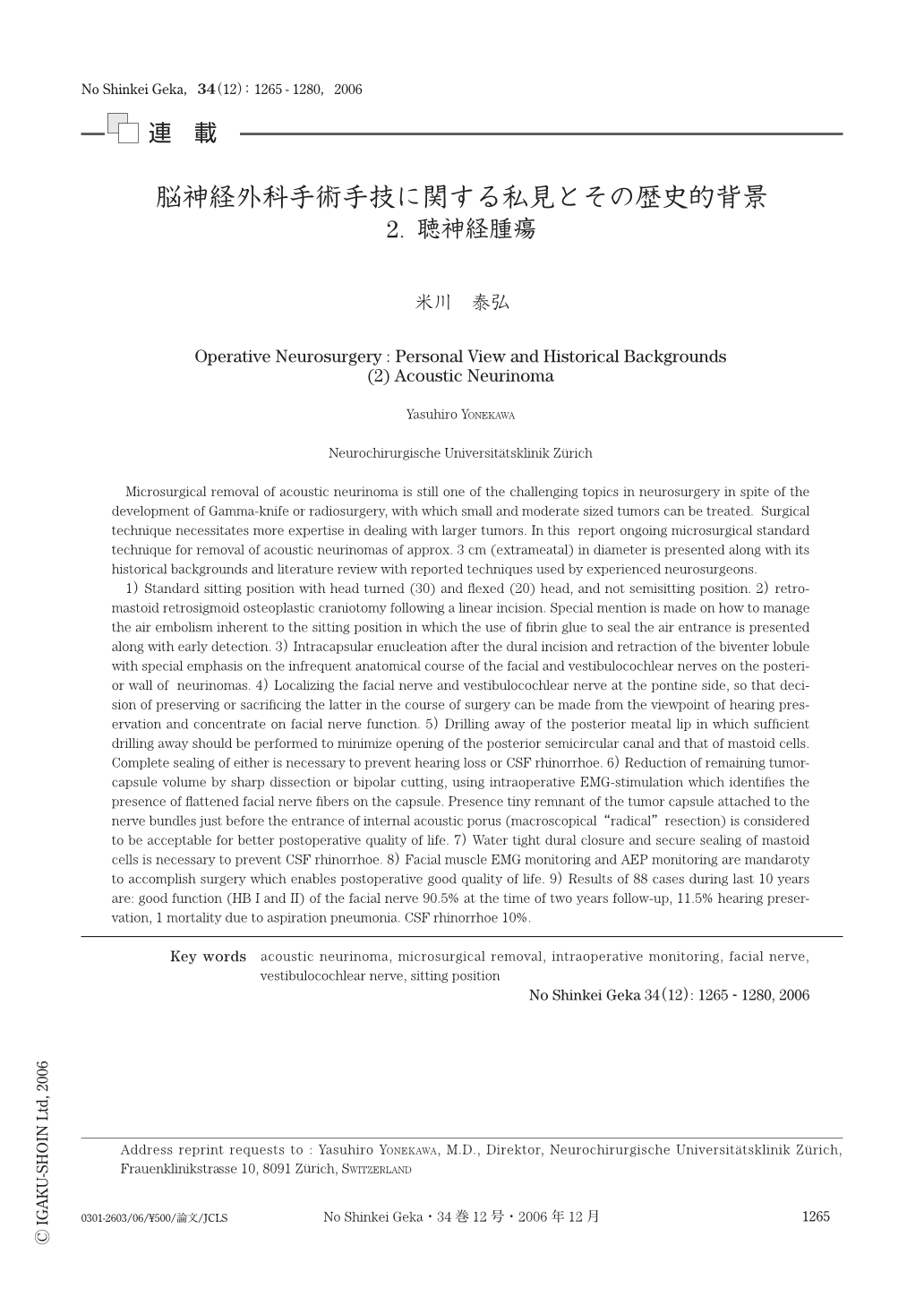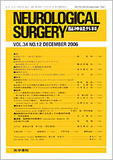Japanese
English
- 有料閲覧
- Abstract 文献概要
- 1ページ目 Look Inside
- 参考文献 Reference
はじめに
聴神経腫瘍acoustic neurinomaが脳神経外科手術の修練-training-Ausbildungの最終課題の1つであるというのは洋の東西を問わずに云われることである.これは局所解剖の十分な理解と,腫瘍摘出に際して頭蓋底深部での狭い術野での手術操作ができることが要求されるからである.1970年代の中ごろ,ZurichでProf. Kurzeの講演を聴いたのが,初めてのこのトピックの重大さ,難しさとの出会いであった.Prof. Kurzeは,1961年にそれまでProf. Houseの助手としてtranslabylinthineに腫瘍摘出を行っていたのをsuboccipitalに変換し,1965年にProf. Randとtransmealtalにacoustic neurinomaの全摘とfacial nerveの保存を発表していたのである13).Prof. Kurzeはmicroneurosurgeryの夜明けの時代,1970年代の初めに京都で行われた半田 肇先生(京都大学名誉教授)主宰のシンポジウムの主賓であった.私はその頃Zurichにいて事情に疎く,この頃のProf. Kurzeの業績を知らなかった.1970年代初頭にここZurichで彼の講演と,手術のデモンストレーションを身近に体験した.手術は,イタリア人でSinus sagittalis superior中1/3のparasagittal meningiomaの再々発症例であった.座位での手術であったが,中途でProf. Yaşargilに手術を引き渡し,Prof. Yaşagilもcentral regionの内側に位置しているということもあって,その腫瘍を,結局かなり取り残して終了したのである.後日,ゲーテボルグのProf. Norlenのところに治療を受けにいったこの患者さんのmenigiomaは,肉眼手術で首尾よく全摘されたということを聞いた.これは静脈側副路がよく発達していたためである.
その講演の詳しい内容はもう覚えてないが,彼はこのacoustic neurinomaの手術の前日には海辺の波打ち際で,裸足で波の押し寄せる砂浜を歩きながら片足は海水の中につけ,片足は砂地を踏みしめ歩きながら手術のstrategyを考える,とのことであった.Prof. Yaşagilのacoustic neurinomaのroutineを見ていた私は,それほどまで深刻に考えなければならぬテーマかとも思った.ただしひょっとしたら,波打ち際をacoustic neurinomaを取り巻くくも膜に例えて比喩的に手術の際の心がまえを述べていたかもしれない.
外科手術はどれでもそうであるが,このacoustic neurinomaほど,症例を重ねて経験を積むことにより,術後の臨床成績(主としてfacial nerve機能保存,聴力保存)がよくなり,手術所要時間が明らかに短縮する脳神経外科手術はない.
こちらに着任した1993年当初,この手術ばかりは先人が行った方法に改良を加える新たな手立てがなく,またガンマナイフが治療として加わり,microneurosurgeonとしては出る幕がなくなる,もしくは,なくなったのではないかと思ったが,どちらもそうではないらしいことも分かってきた.私どもが担当するのはガンマナイフが敬遠する3cm以上,すなわちextrameatalが2cmを越えるもの(平均2.9cm)ばかりである(KoosのGradeⅢ/Ⅳ7)).
最近ふとしたきっかけで,1998年に出版されたProf. Malisの『Acoustic Neuroma』9)を読む機会があった.序文をProf. Yaşargilに依頼しているのが永年の御親交を物語っている.Prof. Malisとは1970年代中頃に数回お会いし,また手術の助手もさせていただいた.その頃,craniopharyngiomaの手術のデモンストレ-ションを当科でしていただいたこともある.その時には,大きなcraniopharyngiomaであったが頭蓋内血管の走行がつまびらかでなく,“血管撮影なしにこの手術を続行することはできない”,“このような手術は友達に課するものではなく,enemyに課するものである”と途中で笑って冗談を言いながらProf. Yaşagilにバトンタッチをされたものである.またその際に,内耳道meatus acusticus internus(MAI)の入り口の硬膜からの出血に関して,“Porus acusticus internus 近傍での出血は時計の文字の位置の12時と6時の2点から起こる”とコメントされたことは今でも耳に残っている.12時の点はA. tentorii Bernasconi-Cassinari あるいはmiddle meningeal artery を経由した硬膜枝から,6時の点はvertebral artery,occipital arteryあるいはascending pharyngeal arteryを経由した硬膜枝からの出血である.このことを知っておくと,近接するfacial あるいはvestibulocochleal nervesに注意しながら出血点を処理できるというものである.
さて,その『Acoustic Neuroma(タイトルはneurinomaでなくneuromaとなっている.最近の諸家の論文ではvestibular schwannomaとのタイトルを散見する)』の本に話を戻すと,Prof. Yaşargilはその序文の中でAVM(anteriovenous malformation)など他の脳神経外科の領域についてもこの『Acoustic Neuroma』のごとく書いて欲しいと望まれていたが,それを果たされることもなく昨年,鬼籍に入られた.“AVMは時としてdraining vein 側から摘出するととよい”など常人では思いつかぬことを言われたことを思い出すと,またこの本の処々で伺うことができる発想,着眼点のユニークさを思うとまさにその通りで残念なことである.またこのテーマは脳神経外科医の経験,philosophyを開陳する格好のテ-マであるとも思ったものである.
この稿では現在,当科で私が行っているacoustic neurinomaの手術の実際について述べ,なぜそうするに至ったのか基本的なことに考えをめぐらせてみたい.体位,頭位の取り方から最後の皮膚縫合まで,視ながら覚えたものをなぜそうしているのか自分で理解している範囲で,当科の手術の原則について,諸家の見解,レポ-トを比較顧慮しながら述べてみる.
実際に私がacoustic neurinomaを自分で手術し始めたのは,京都で半田先生のもとであった.日本で23例(1983~1992年),Zurichで104例(1993~2005年)の自験例である.この間,動脈瘤症例を1,200例あまり経験した.Samii教授の1,000例のneuroma 15,16)に比べるとbescheiden(たいしたことのない)な症例数であるが,ガンマナイフがacoustic neurinomaの治療選択肢となり,脳神経外科医が扱う症例が大きな腫瘍症例に限られつつある中で,これらをどう扱っているかを知っていただくには,また,どうしてうまくいかなかったかを知っていただくには十分な数であると思う.
Prof. Yaşargilのもとで視つつ学び20,21),少しずつmodifyしてきた手術の手順,手技(facial nerve 温存のためのstimulation-mirror でのチェックを含む), 成績については,当時, 帝京大学教授の田村 晃先生が会長のときの第15回日本脳神経外科コングレスで報告した24).それから10余年経ってEMG-stimulation monitoringおよびauditory evoked potential,AEP)の使用5,10)を含めて,どの程度のLernprozess学習習得過程があったかについて考察するので参考にしていただければ幸甚である.
Microsurgical removal of acoustic neurinoma is still one of the challenging topics in neurosurgery in spite of the development of Gamma-knife or radiosurgery,with which small and moderate sized tumors can be treated. Surgical technique necessitates more expertise in dealing with larger tumors. In this report ongoing microsurgical standard technique for removal of acoustic neurinomas of approx. 3 cm (extrameatal) in diameter is presented along with its historical backgrounds and literature review with reported techniques used by experienced neurosurgeons.
1) Standard sitting position with head turned (30) and flexed (20) head,and not semisitting position. 2) retromastoid retrosigmoid osteoplastic craniotomy following a linear incision. Special mention is made on how to manage the air embolism inherent to the sitting position in which the use of fibrin glue to seal the air entrance is presented along with early detection. 3) Intracapsular enucleation after the dural incision and retraction of the biventer lobule with special emphasis on the infrequent anatomical course of the facial and vestibulocochlear nerves on the posterior wall of neurinomas. 4) Localizing the facial nerve and vestibulocochlear nerve at the pontine side,so that decision of preserving or sacrificing the latter in the course of surgery can be made from the viewpoint of hearing preservation and concentrate on facial nerve function. 5) Drilling away of the posterior meatal lip in which sufficient drilling away should be performed to minimize opening of the posterior semicircular canal and that of mastoid cells. Complete sealing of either is necessary to prevent hearing loss or CSF rhinorrhoe. 6) Reduction of remaining tumor-capsule volume by sharp dissection or bipolar cutting,using intraoperative EMG-stimulation which identifies the presence of flattened facial nerve fibers on the capsule. Presence tiny remnant of the tumor capsule attached to the nerve bundles just before the entrance of internal acoustic porus (macroscopical“radical”resection) is considered to be acceptable for better postoperative quality of life. 7) Water tight dural closure and secure sealing of mastoid cells is necessary to prevent CSF rhinorrhoe. 8) Facial muscle EMG monitoring and AEP monitoring are mandaroty to accomplish surgery which enables postoperative good quality of life. 9) Results of 88 cases during last 10 years are: good function (HB I and II) of the facial nerve 90.5% at the time of two years follow-up,11.5% hearing preservation,1 mortality due to aspiration pneumonia. CSF rhinorrhoe 10%.

Copyright © 2006, Igaku-Shoin Ltd. All rights reserved.


